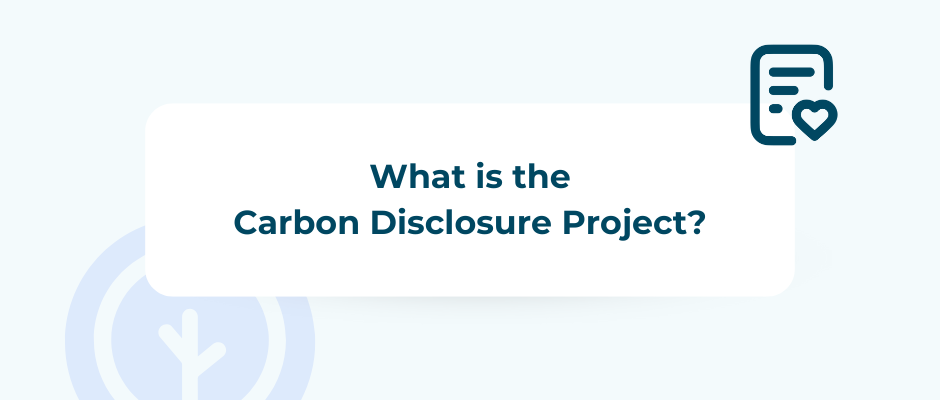Carbon Disclosure Project (CDP): what it is and how it works
Reading time: 5 minutes
Reading time: 5 minutes

If your company operates in the EU and aims to build a credible climate strategy, understanding the Carbon Disclosure Project (CDP) is essential. CDP is now the global gold standard for environmental disclosure, and over 22,700 companies use it to share data on greenhouse gas emissions, water use, forests, plastics, and biodiversity. CDP reporting strengthens your sustainability credentials and aligns closely with the EU’s evolving regulatory framework, including CSRD and ESRS requirements.
In this article, you’ll discover how CDP works, why EU companies benefit from it, how to prepare, what to report, and how to turn disclosure into action. We’ll explore real data, illustrate high‑impact cases, explain the scoring system, and offer fresh perspectives on integrating CDP into your climate governance. By the end, you’ll see how CDP can be a strategic ally in your decarbonisation journey.
CDP, initially founded in 2000 as the Carbon Disclosure Project, is a global non‑profit that operates the world’s largest platform for environmental disclosure. It aims to make environmental reporting and risk management a business norm. CDP supports companies, cities, states and regions in transparently sharing self‑reported data on greenhouse gas emissions, climate risks, water use, deforestation, plastics, and biodiversity.
Entities respond to an annual integrated questionnaire covering governance, business strategy, environmental performance, and sector‑specific topics. Questions draw upon recognised frameworks like the GHG Protocol and align with TCFD principles.
The data you submit is scored across transparency and performance criteria. CDP compiles these into public datasets, ranking high‑performing organisations on its A‑list.
EU legislation now demands rigorous non‑financial reporting. The Corporate Sustainability Reporting Directive (CSRD), effective January 2024, requires companies to publish disclosures on environmental matters, including climate, biodiversity and social governance. Meanwhile, the European Sustainability Reporting Standards (ESRS) have just been adopted, shaping mandatory metrics for climate, governance, risk, and performance.
CDP reporting prepares you in advance. Many companies disclose through CDP reports on governance, strategy, and climate risk—critical components under ESRS.
Major investors and corporations increasingly demand CDP data. Disclosing builds trust. According to CDP, companies that respond to an investor request reduce direct emissions by 7–10 % within two years. Investor-aligned climate transition plans rose 44 % in 2023—yet only 2 % of companies disclosed full details on all 21 indicators. That underscores why transparent, comprehensive reporting matters.
Since 2024, CDP has used a unified integrated questionnaire which covers climate, water, forests, plastics, and biodiversity in one tool. The questionnaire is structured in modules: governance, business strategy, environmental performance, plus issue‑specific sections such as forests or water security.
Key dates in the cycle (2025 example):
CDP scores measure:
High scores earn your company a place on CDP’s A‑list, which is a public recognition of leadership.
Start by registering on CDP’s portal and understanding your questionnaire type—corporate or SME. Define organisational boundaries: parent company, subsidiaries, who holds operational control, and how emissions should be allocated.
To gather data, create a cross‑functional team—finance, operations, HR, and sustainability. Clarify responsibilities and timelines, and explain why CDP matters to the business internally.
The climate questionnaire requires Scope 1 (direct), Scope 2 (indirect energy), and Scope 3 (value‑chain) emissions. Document your sources, methodology, and assurance process. Transparency here strengthens credibility.
Disclosing isn’t just a box‑ticking exercise—it drives change. CDP reports that companies reduce direct emissions by 7–10 % within two years after an investor request. That’s real impact.
More EU companies are implementing climate transition plans in line with 1.5 °C. Yet only a small share discloses all required indicators. Filling gaps in your CDP disclosure earns investor confidence and positions your strategy as credible.
A 2023 Capgemini‑CDP report shows that while 92 % of emissions disclosed by European businesses were Scope 3, only 37 % are addressed by decarbonisation measures. Direct emissions dropped 14 % between 2019 and 2022, but Scope 3 remains under‑managed. That’s a warning that you must tackle value‑chain emissions, not just operational ones.
Companies may hold back from full disclosure due to fear of scrutiny (so‑called “greenhushing”) or lack of data quality. Studies show 39 % of CDP climate transition plans disclosed only two‑thirds of the required metrics. And some industries exhibit poor data integrity; for example, nearly 39 % of oil and gas CDP reports failed basic arithmetic consistency tests. Aim for accuracy and fullness in your response.
The Carbon Disclosure Project (CDP) is much more than data submission—it’s a lever for European companies to align with regulatory demands, create stakeholder trust, and drive real climate action. By participating in CDP:
Starting your CDP journey early gives you a head start in embedding sustainability into your business DNA. Begin by registering today, building a reporting team, and integrating CDP modules into your strategy. If you’d like support mapping your first CDP disclosure or aligning it with your climate goals, Tapio’s experts and carbon management software are here to help.

Tapio is a carbon management software that allows companies and consultants to calculate and reduce carbon emissions.